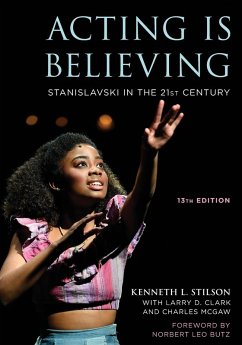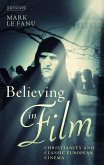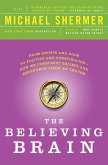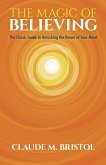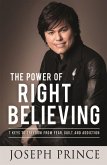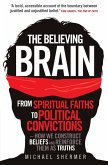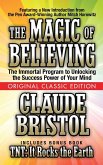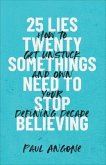- Broschiertes Buch
- Merkliste
- Auf die Merkliste
- Bewerten Bewerten
- Teilen
- Produkt teilen
- Produkterinnerung
- Produkterinnerung
Acting is Believing has remained one of the classic acting texts that continues to set the standard in the field, using the Stanislavski method to teach students the fundamentals of acting for stage or screenâ now updated for the 21st century student and actor.
Andere Kunden interessierten sich auch für
![Believing in Film Believing in Film]() Mark Le Fanu (UK University College London)Believing in Film33,99 €
Mark Le Fanu (UK University College London)Believing in Film33,99 €![The Believing Brain The Believing Brain]() Michael ShermerThe Believing Brain22,99 €
Michael ShermerThe Believing Brain22,99 €![The Magic of Believing The Magic of Believing]() Claude BristolThe Magic of Believing12,99 €
Claude BristolThe Magic of Believing12,99 €![The Power of Right Believing The Power of Right Believing]() Joseph PrinceThe Power of Right Believing14,99 €
Joseph PrinceThe Power of Right Believing14,99 €![The Believing Brain The Believing Brain]() Michael ShermerThe Believing Brain16,99 €
Michael ShermerThe Believing Brain16,99 €![The Magic of Believing (Original Classic Edition) The Magic of Believing (Original Classic Edition)]() Claude BristolThe Magic of Believing (Original Classic Edition)20,99 €
Claude BristolThe Magic of Believing (Original Classic Edition)20,99 €![25 Lies Twentysomethings Need to Stop Believing - How to Get Unstuck and Own Your Defining Decade 25 Lies Twentysomethings Need to Stop Believing - How to Get Unstuck and Own Your Defining Decade]() Paul Angone25 Lies Twentysomethings Need to Stop Believing - How to Get Unstuck and Own Your Defining Decade16,99 €
Paul Angone25 Lies Twentysomethings Need to Stop Believing - How to Get Unstuck and Own Your Defining Decade16,99 €-
-
-
Acting is Believing has remained one of the classic acting texts that continues to set the standard in the field, using the Stanislavski method to teach students the fundamentals of acting for stage or screenâ now updated for the 21st century student and actor.
Hinweis: Dieser Artikel kann nur an eine deutsche Lieferadresse ausgeliefert werden.
Hinweis: Dieser Artikel kann nur an eine deutsche Lieferadresse ausgeliefert werden.
Produktdetails
- Produktdetails
- Verlag: Rowman & Littlefield
- Thirteenth Edition
- Seitenzahl: 356
- Erscheinungstermin: 25. Mai 2023
- Englisch
- Abmessung: 254mm x 178mm x 19mm
- Gewicht: 758g
- ISBN-13: 9781538171776
- ISBN-10: 1538171775
- Artikelnr.: 66352800
- Herstellerkennzeichnung
- Produktsicherheitsverantwortliche/r
- Europaallee 1
- 36244 Bad Hersfeld
- gpsr@libri.de
- Verlag: Rowman & Littlefield
- Thirteenth Edition
- Seitenzahl: 356
- Erscheinungstermin: 25. Mai 2023
- Englisch
- Abmessung: 254mm x 178mm x 19mm
- Gewicht: 758g
- ISBN-13: 9781538171776
- ISBN-10: 1538171775
- Artikelnr.: 66352800
- Herstellerkennzeichnung
- Produktsicherheitsverantwortliche/r
- Europaallee 1
- 36244 Bad Hersfeld
- gpsr@libri.de
SSN:493-72-5520
Foreword by Norbert Leo Butz
Preface
Acknowledgments
Chapter 1A: Life in Art
Acting with Professional Competence
The Six Parts of Actor Training
The Business of Acting
Acting is Believing: Stanislavski in the 21st Century
External Resources
Chapter 2: The Creative State
Body Training
Breathing and Posture
Exercise 2.1 Breathing
Exercise 2.2 Posture
The Creative State
Exercise 2.3 Aerobic
Exercise 2.4 Stretching
Exercise 2.5 Moving
Exercise 2.6 Vocalizing
On Anxiety
Physical Tension
Social Inhibitions
Nudity and Intimacy
Chapter 3: The Choice of Actions
Exercise 3.1 Given Circumstances and Imagination
Commitment to Actions
Belief in Actions
Improvisational Technique
Exercise 3.2 Improvising Simple Tasks
Exercise 3.3 Recalling a Special Memory
Scoring Physical Actions
Tempo/Rhythm
Exercise 3.4 Scores from Scenarios
Chapter 4: Stanislavski's Method of Physical Actions
Simple Objectives
Exercise 4.1 Refining Your Score
Action Verbs
Exercise 4.2 Actions from an Emotional State
Exercise 4.3 Everyday Actions
Physical and Psychological Obstacles
Strategy and Desire
Expectations and Adaptations
Nonverbal Group Improvisations
Exercise 4.4 Waiting
Exercise 4.5 Not on Speaking Terms
Verbal Group Improvisations
Exercise 4.6 Opposing Objectives
Exercise 4.7 Improvisation from Action Verbs
Exercise 4.8 Non-Content Scenes
Chapter 5: Observation
Exercise 5.1 Playing a Condition
Exercise 5.2 Three Objects
Exercise 5.3 Adjusting to Conditions
Observing People
Exercise 5.4 Observation Notebook
Exercise 5.5 Creating an Actor's Image Collage
Adapting Your Observations
Exercise 5.6 Observing Visual Art
Abstraction
Exercise 5.7 Abstractions from Inanimate Objects
Exercise 5.8 Abstraction from Animals
Chapter 6: Circles of Attention
Exercise 6.1 Distractions
Exercise 6.2 Add-a-Word
Public Solitude
The Small Circle
Exercise 6.3 Objects in the Small Circle
Communion
Exercise 6.4 Mirrors
Exercise 6.5 Silent Argument
Communion with the Audience
Dramatic Action in Speech
Exercise 6.6 Key Line Improvisation
Chapter 7: Emotion Memory
Stanislavski and Emotion Memory
Retaining an Emotion Memory
Selecting the Emotion Memory
Using the Emotion Memory
Emotional Triggers
Exercise 7.1 Reconstructing a Personal Memory
Inner Images
Exercise 7.2 Verbalizing Images
Exercise 7.3 Image Improvisations
Inner Monologues
Exercise 7.4 Inner Monologues
Chapter 8: Creating a Character
Script Analysis
The World of the Play
Exercise 8.1 Historical Imagination
Character Autobiography
Exercise 8.2 Character Autobiography
Exercise 8.3 If It Were Up to Me...
Second Plan
Exercise 8.4 Second Plan
External Expression
Units of Action
Scoring
Exercise 8.5 Scoring a Role
The Motivating Force
Exercise 8.6 Motivating Force
The Super-Objective
Exercise 8.7 Super-Objective
Summary
Chapter 9: Subtext
Exercise 9.1 Improvising Subtext
Verbal Action
Exercise 9.2 Text, Subtext, and Verbal Action
Relating the Lines to the Motivating Force
Relating the Lines to the Super-Objective
Manners of Speaking
Dialects and Accents
Exercise 9.4 Speech Patterns
Longer Speeches
Exercise 9.5 Verbal Actions in Longer Speeches
Chapter 10: The Power of Words
Meaning, Operative Words, and Idioms
Sentence Structure
Progressions
Antithesis
Secondary Inner Images
Exercise 10.1 Longer Speeches
Chapter 11: Reincarnation
Tablework and Early Discoveries
Working Rehearsals
Exercise 11.1 Putting Spontaneity into Physical Choices
Run-throughs and Technical Rehearsals
Performances
Chapter 12: The Business of Acting
Understanding the Business
Business Plan
Exercise 12.1 The Actor's Business Plan
Exercise 12.2 The Elevator Pitch
Headshots and Resumes
Exercise 12.3 Resume
Introductory and Follow-up Emails
Exercise 12.4 Introductory and Follow-up Emails
Preparing Your Audition
Exercise 12.5 Audition Preparation - Working Off a Partner
Auditioning
Exercise 12.6 Moment Before
Exercise 12.7 Laughing at the Top
Exercise 12.8 Portfolio
Appendix A: Self-Directed Scene Study
Appendix B: Glossary
Bibliography
Index
Preface
Acknowledgments
Chapter 1A: Life in Art
Acting with Professional Competence
The Six Parts of Actor Training
The Business of Acting
Acting is Believing: Stanislavski in the 21st Century
External Resources
Chapter 2: The Creative State
Body Training
Breathing and Posture
Exercise 2.1 Breathing
Exercise 2.2 Posture
The Creative State
Exercise 2.3 Aerobic
Exercise 2.4 Stretching
Exercise 2.5 Moving
Exercise 2.6 Vocalizing
On Anxiety
Physical Tension
Social Inhibitions
Nudity and Intimacy
Chapter 3: The Choice of Actions
Exercise 3.1 Given Circumstances and Imagination
Commitment to Actions
Belief in Actions
Improvisational Technique
Exercise 3.2 Improvising Simple Tasks
Exercise 3.3 Recalling a Special Memory
Scoring Physical Actions
Tempo/Rhythm
Exercise 3.4 Scores from Scenarios
Chapter 4: Stanislavski's Method of Physical Actions
Simple Objectives
Exercise 4.1 Refining Your Score
Action Verbs
Exercise 4.2 Actions from an Emotional State
Exercise 4.3 Everyday Actions
Physical and Psychological Obstacles
Strategy and Desire
Expectations and Adaptations
Nonverbal Group Improvisations
Exercise 4.4 Waiting
Exercise 4.5 Not on Speaking Terms
Verbal Group Improvisations
Exercise 4.6 Opposing Objectives
Exercise 4.7 Improvisation from Action Verbs
Exercise 4.8 Non-Content Scenes
Chapter 5: Observation
Exercise 5.1 Playing a Condition
Exercise 5.2 Three Objects
Exercise 5.3 Adjusting to Conditions
Observing People
Exercise 5.4 Observation Notebook
Exercise 5.5 Creating an Actor's Image Collage
Adapting Your Observations
Exercise 5.6 Observing Visual Art
Abstraction
Exercise 5.7 Abstractions from Inanimate Objects
Exercise 5.8 Abstraction from Animals
Chapter 6: Circles of Attention
Exercise 6.1 Distractions
Exercise 6.2 Add-a-Word
Public Solitude
The Small Circle
Exercise 6.3 Objects in the Small Circle
Communion
Exercise 6.4 Mirrors
Exercise 6.5 Silent Argument
Communion with the Audience
Dramatic Action in Speech
Exercise 6.6 Key Line Improvisation
Chapter 7: Emotion Memory
Stanislavski and Emotion Memory
Retaining an Emotion Memory
Selecting the Emotion Memory
Using the Emotion Memory
Emotional Triggers
Exercise 7.1 Reconstructing a Personal Memory
Inner Images
Exercise 7.2 Verbalizing Images
Exercise 7.3 Image Improvisations
Inner Monologues
Exercise 7.4 Inner Monologues
Chapter 8: Creating a Character
Script Analysis
The World of the Play
Exercise 8.1 Historical Imagination
Character Autobiography
Exercise 8.2 Character Autobiography
Exercise 8.3 If It Were Up to Me...
Second Plan
Exercise 8.4 Second Plan
External Expression
Units of Action
Scoring
Exercise 8.5 Scoring a Role
The Motivating Force
Exercise 8.6 Motivating Force
The Super-Objective
Exercise 8.7 Super-Objective
Summary
Chapter 9: Subtext
Exercise 9.1 Improvising Subtext
Verbal Action
Exercise 9.2 Text, Subtext, and Verbal Action
Relating the Lines to the Motivating Force
Relating the Lines to the Super-Objective
Manners of Speaking
Dialects and Accents
Exercise 9.4 Speech Patterns
Longer Speeches
Exercise 9.5 Verbal Actions in Longer Speeches
Chapter 10: The Power of Words
Meaning, Operative Words, and Idioms
Sentence Structure
Progressions
Antithesis
Secondary Inner Images
Exercise 10.1 Longer Speeches
Chapter 11: Reincarnation
Tablework and Early Discoveries
Working Rehearsals
Exercise 11.1 Putting Spontaneity into Physical Choices
Run-throughs and Technical Rehearsals
Performances
Chapter 12: The Business of Acting
Understanding the Business
Business Plan
Exercise 12.1 The Actor's Business Plan
Exercise 12.2 The Elevator Pitch
Headshots and Resumes
Exercise 12.3 Resume
Introductory and Follow-up Emails
Exercise 12.4 Introductory and Follow-up Emails
Preparing Your Audition
Exercise 12.5 Audition Preparation - Working Off a Partner
Auditioning
Exercise 12.6 Moment Before
Exercise 12.7 Laughing at the Top
Exercise 12.8 Portfolio
Appendix A: Self-Directed Scene Study
Appendix B: Glossary
Bibliography
Index
Foreword by Norbert Leo Butz
Preface
Acknowledgments
Chapter 1A: Life in Art
Acting with Professional Competence
The Six Parts of Actor Training
The Business of Acting
Acting is Believing: Stanislavski in the 21st Century
External Resources
Chapter 2: The Creative State
Body Training
Breathing and Posture
Exercise 2.1 Breathing
Exercise 2.2 Posture
The Creative State
Exercise 2.3 Aerobic
Exercise 2.4 Stretching
Exercise 2.5 Moving
Exercise 2.6 Vocalizing
On Anxiety
Physical Tension
Social Inhibitions
Nudity and Intimacy
Chapter 3: The Choice of Actions
Exercise 3.1 Given Circumstances and Imagination
Commitment to Actions
Belief in Actions
Improvisational Technique
Exercise 3.2 Improvising Simple Tasks
Exercise 3.3 Recalling a Special Memory
Scoring Physical Actions
Tempo/Rhythm
Exercise 3.4 Scores from Scenarios
Chapter 4: Stanislavski's Method of Physical Actions
Simple Objectives
Exercise 4.1 Refining Your Score
Action Verbs
Exercise 4.2 Actions from an Emotional State
Exercise 4.3 Everyday Actions
Physical and Psychological Obstacles
Strategy and Desire
Expectations and Adaptations
Nonverbal Group Improvisations
Exercise 4.4 Waiting
Exercise 4.5 Not on Speaking Terms
Verbal Group Improvisations
Exercise 4.6 Opposing Objectives
Exercise 4.7 Improvisation from Action Verbs
Exercise 4.8 Non-Content Scenes
Chapter 5: Observation
Exercise 5.1 Playing a Condition
Exercise 5.2 Three Objects
Exercise 5.3 Adjusting to Conditions
Observing People
Exercise 5.4 Observation Notebook
Exercise 5.5 Creating an Actor's Image Collage
Adapting Your Observations
Exercise 5.6 Observing Visual Art
Abstraction
Exercise 5.7 Abstractions from Inanimate Objects
Exercise 5.8 Abstraction from Animals
Chapter 6: Circles of Attention
Exercise 6.1 Distractions
Exercise 6.2 Add-a-Word
Public Solitude
The Small Circle
Exercise 6.3 Objects in the Small Circle
Communion
Exercise 6.4 Mirrors
Exercise 6.5 Silent Argument
Communion with the Audience
Dramatic Action in Speech
Exercise 6.6 Key Line Improvisation
Chapter 7: Emotion Memory
Stanislavski and Emotion Memory
Retaining an Emotion Memory
Selecting the Emotion Memory
Using the Emotion Memory
Emotional Triggers
Exercise 7.1 Reconstructing a Personal Memory
Inner Images
Exercise 7.2 Verbalizing Images
Exercise 7.3 Image Improvisations
Inner Monologues
Exercise 7.4 Inner Monologues
Chapter 8: Creating a Character
Script Analysis
The World of the Play
Exercise 8.1 Historical Imagination
Character Autobiography
Exercise 8.2 Character Autobiography
Exercise 8.3 If It Were Up to Me...
Second Plan
Exercise 8.4 Second Plan
External Expression
Units of Action
Scoring
Exercise 8.5 Scoring a Role
The Motivating Force
Exercise 8.6 Motivating Force
The Super-Objective
Exercise 8.7 Super-Objective
Summary
Chapter 9: Subtext
Exercise 9.1 Improvising Subtext
Verbal Action
Exercise 9.2 Text, Subtext, and Verbal Action
Relating the Lines to the Motivating Force
Relating the Lines to the Super-Objective
Manners of Speaking
Dialects and Accents
Exercise 9.4 Speech Patterns
Longer Speeches
Exercise 9.5 Verbal Actions in Longer Speeches
Chapter 10: The Power of Words
Meaning, Operative Words, and Idioms
Sentence Structure
Progressions
Antithesis
Secondary Inner Images
Exercise 10.1 Longer Speeches
Chapter 11: Reincarnation
Tablework and Early Discoveries
Working Rehearsals
Exercise 11.1 Putting Spontaneity into Physical Choices
Run-throughs and Technical Rehearsals
Performances
Chapter 12: The Business of Acting
Understanding the Business
Business Plan
Exercise 12.1 The Actor's Business Plan
Exercise 12.2 The Elevator Pitch
Headshots and Resumes
Exercise 12.3 Resume
Introductory and Follow-up Emails
Exercise 12.4 Introductory and Follow-up Emails
Preparing Your Audition
Exercise 12.5 Audition Preparation - Working Off a Partner
Auditioning
Exercise 12.6 Moment Before
Exercise 12.7 Laughing at the Top
Exercise 12.8 Portfolio
Appendix A: Self-Directed Scene Study
Appendix B: Glossary
Bibliography
Index
Preface
Acknowledgments
Chapter 1A: Life in Art
Acting with Professional Competence
The Six Parts of Actor Training
The Business of Acting
Acting is Believing: Stanislavski in the 21st Century
External Resources
Chapter 2: The Creative State
Body Training
Breathing and Posture
Exercise 2.1 Breathing
Exercise 2.2 Posture
The Creative State
Exercise 2.3 Aerobic
Exercise 2.4 Stretching
Exercise 2.5 Moving
Exercise 2.6 Vocalizing
On Anxiety
Physical Tension
Social Inhibitions
Nudity and Intimacy
Chapter 3: The Choice of Actions
Exercise 3.1 Given Circumstances and Imagination
Commitment to Actions
Belief in Actions
Improvisational Technique
Exercise 3.2 Improvising Simple Tasks
Exercise 3.3 Recalling a Special Memory
Scoring Physical Actions
Tempo/Rhythm
Exercise 3.4 Scores from Scenarios
Chapter 4: Stanislavski's Method of Physical Actions
Simple Objectives
Exercise 4.1 Refining Your Score
Action Verbs
Exercise 4.2 Actions from an Emotional State
Exercise 4.3 Everyday Actions
Physical and Psychological Obstacles
Strategy and Desire
Expectations and Adaptations
Nonverbal Group Improvisations
Exercise 4.4 Waiting
Exercise 4.5 Not on Speaking Terms
Verbal Group Improvisations
Exercise 4.6 Opposing Objectives
Exercise 4.7 Improvisation from Action Verbs
Exercise 4.8 Non-Content Scenes
Chapter 5: Observation
Exercise 5.1 Playing a Condition
Exercise 5.2 Three Objects
Exercise 5.3 Adjusting to Conditions
Observing People
Exercise 5.4 Observation Notebook
Exercise 5.5 Creating an Actor's Image Collage
Adapting Your Observations
Exercise 5.6 Observing Visual Art
Abstraction
Exercise 5.7 Abstractions from Inanimate Objects
Exercise 5.8 Abstraction from Animals
Chapter 6: Circles of Attention
Exercise 6.1 Distractions
Exercise 6.2 Add-a-Word
Public Solitude
The Small Circle
Exercise 6.3 Objects in the Small Circle
Communion
Exercise 6.4 Mirrors
Exercise 6.5 Silent Argument
Communion with the Audience
Dramatic Action in Speech
Exercise 6.6 Key Line Improvisation
Chapter 7: Emotion Memory
Stanislavski and Emotion Memory
Retaining an Emotion Memory
Selecting the Emotion Memory
Using the Emotion Memory
Emotional Triggers
Exercise 7.1 Reconstructing a Personal Memory
Inner Images
Exercise 7.2 Verbalizing Images
Exercise 7.3 Image Improvisations
Inner Monologues
Exercise 7.4 Inner Monologues
Chapter 8: Creating a Character
Script Analysis
The World of the Play
Exercise 8.1 Historical Imagination
Character Autobiography
Exercise 8.2 Character Autobiography
Exercise 8.3 If It Were Up to Me...
Second Plan
Exercise 8.4 Second Plan
External Expression
Units of Action
Scoring
Exercise 8.5 Scoring a Role
The Motivating Force
Exercise 8.6 Motivating Force
The Super-Objective
Exercise 8.7 Super-Objective
Summary
Chapter 9: Subtext
Exercise 9.1 Improvising Subtext
Verbal Action
Exercise 9.2 Text, Subtext, and Verbal Action
Relating the Lines to the Motivating Force
Relating the Lines to the Super-Objective
Manners of Speaking
Dialects and Accents
Exercise 9.4 Speech Patterns
Longer Speeches
Exercise 9.5 Verbal Actions in Longer Speeches
Chapter 10: The Power of Words
Meaning, Operative Words, and Idioms
Sentence Structure
Progressions
Antithesis
Secondary Inner Images
Exercise 10.1 Longer Speeches
Chapter 11: Reincarnation
Tablework and Early Discoveries
Working Rehearsals
Exercise 11.1 Putting Spontaneity into Physical Choices
Run-throughs and Technical Rehearsals
Performances
Chapter 12: The Business of Acting
Understanding the Business
Business Plan
Exercise 12.1 The Actor's Business Plan
Exercise 12.2 The Elevator Pitch
Headshots and Resumes
Exercise 12.3 Resume
Introductory and Follow-up Emails
Exercise 12.4 Introductory and Follow-up Emails
Preparing Your Audition
Exercise 12.5 Audition Preparation - Working Off a Partner
Auditioning
Exercise 12.6 Moment Before
Exercise 12.7 Laughing at the Top
Exercise 12.8 Portfolio
Appendix A: Self-Directed Scene Study
Appendix B: Glossary
Bibliography
Index

